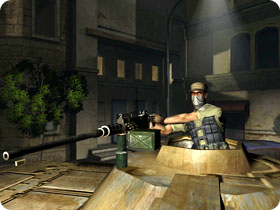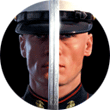Simultaneously released for Mac and PC, which Tamte says “was a priority for us,” First to Fight marks the debut of a unique psychology model. Like other tactical first-person shooters with a military setting, this game puts you in charge of troops and lets you issue orders to them, but it also gives those men complex psychologies that constantly change as events unfold, which in turn affects their ability to carry out your commands.
The psychology model becomes the digital equivalent of the human will, which is so important to the Marines that they emphasize it on page 10 of the first book that every new recruit reads.

Crowded Conditions. Stand your ground during a heated firefight indoors.
What Goes Up Must Come Down
“The AI [artificial intelligence] in this game is so complicated that we had to put a huge flowchart on the wall just to keep track of everything,” says Tamte.
That flowchart dictated the computer-controlled characters’ basic responses, which formed a foundation for the psychology model. Each character in the game, whether on your side or the enemy’s, carries morale and discipline values that ultimately determine his actions.
“The Marines emphasized to us: ‘You can’t call your game authentic unless you deal with the human will.’”
- Peter Tamte, president, MacSoft
“The psychology model makes things unpredictable,” notes Tamte. “It depends on what happens in the game, which causes values to go up and down all over the place.”
Depending on changes in their morale and discipline, enemy forces might flee, surrender, become confused, strengthen their resolve, or even alter their level of aggression. You encounter different enemy factions during the 21 levels of action in First to Fight — each features its own fighting tactics as well as a specific attitude toward the other factions that’s built into the psychology model. For example, the loss of another faction’s leader may or may not affect a certain group, but the loss of their leader definitely will.

Stair Climbing. Any place can turn into a battleground.
Watch out, though: the enemy may feign surrender, only to grab a weapon and use it against one of your marines, an action also driven by psychology. “For example,” says Tamte, “he surrenders and sees two of his buddies coming in from the side, so he’ll get confidence.” Hopefully your marine will catch him first.
Tell Me How Your Team Feels About You
First to Fight’s psychology engine also drives the actions of the other marines in your fire team, known as “Ready Team Fire Assist” (RTFA). “Ready” refers to the rifleman who provides cover in a specific direction. You fill the role of “Team,” who issues orders. The marine who occupies the “Fire” slot carries a SAW (Squad Automatic Weapon) machine gun and covers the direction opposite the rifleman. The “Assist” man brings up the rear, supplying ammo to the SAW gunner and keeping an eye out for enemy troops approaching from behind.

Say ‘Hello’ to My Little Friend. An enemy soldier mans his armored position.
“The fire team provides 360-degree security as you move through the urban environment,” says Tamte. “You don’t want to micro-manage them, though — let them act as they’ve been trained. They provide better security than you could if you had to tell them what to do.”
As you lead your team through a level, each of which features one to three “scenes,” your fellow digital marines follow the same procedures instilled in real ones, such as automatically grabbing a street corner and providing cover in a specific direction.
Game Hardware
Check out our systems for your best gaming experience.
- Site: Close Combat: First to Fight
- Publisher: MacSoft
- Developer: Destineer Studios
- Genre: Action
Game Media
“It’s interesting to watch real marines play the game. Most players whip right through, but they’re more cautious. There is no checkpoint reset for them in real life.”
- Tamte
And just like in real life, their psychology models dictate how well they do their jobs.
Your leadership affects those complex algorithms much as it would affect real people: make a dumb move and your team’s morale and discipline values will drop. While your teammates know what to do most of the time, you still need to issue orders when you want them to storm a room, engage the enemy or take similar action.
Success depends on giving your marines the correct strategic orders before the bullets start flying, but once you engage hostile forces, they put their finely-tuned teammate skills to work. Tamte elaborates: “They will communicate with each other to achieve multiple lines of fire against the enemy. Understanding that and getting your marines into the right places will give you an advantage.”

Enemy Location Spotted. Plenty of stuff in the environment provides good cover.
Summoning Additional Help
No RTFA team ever deploys alone, however: it’s always part of a unit known as a Marine Air Ground Task Force (MAGTF), and the same holds true in First to Fight. As team leader, you can call on snipers, mortar teams, and Cobra gunships to provide help when you need it. You can only bring them in under specific circumstances and only against certain targets, however, since you’re bound by the same rules of engagement that govern the behavior of real marines.
“The psychology model makes things unpredictable. It depends on what happens in the game, which causes values to go up and down all over the place.”
- Tamte
“One of the subjects of debate in development has been how quick those assets show up,” says Tamte. “Players are so used to instantaneous results, but we wanted to give them a sense of suspense. If they’re in the middle of a firefight, they can’t just push the magic button and have it taken care of — it takes time for a request to be relayed up and down the chain of command.”

Cover Me. A Marine approaches the enemy.
While gunships and mortars always hit their targets in First to Fight, snipers sometimes miss, and gunships can be shot down. Just like in real life, such occurrences complicate a situation, forcing you to think quick if you want to recover from the blown opportunity. To understand how marines deal with such difficulties, try doing so without pressing the pause key.
“It’s interesting to watch real marines play the game,” says Tamte. “Most players whip right through, but they’re more cautious. There is no checkpoint reset for them in real life.”


